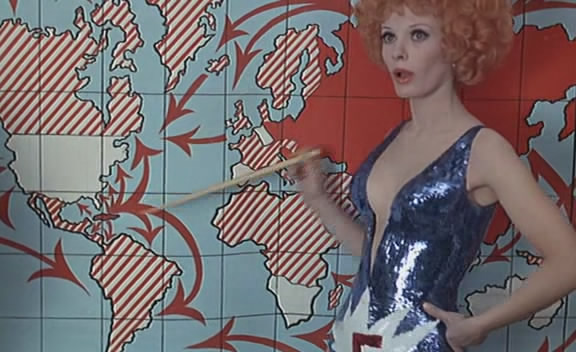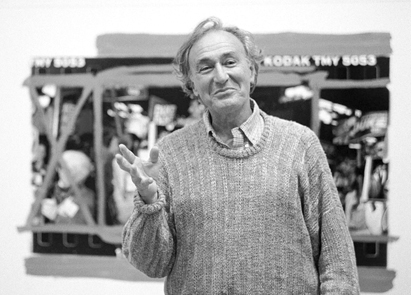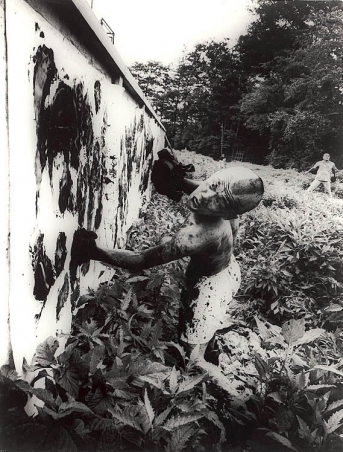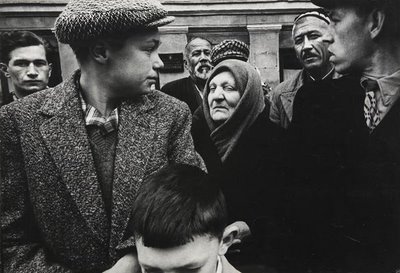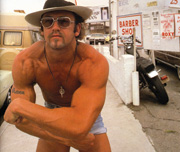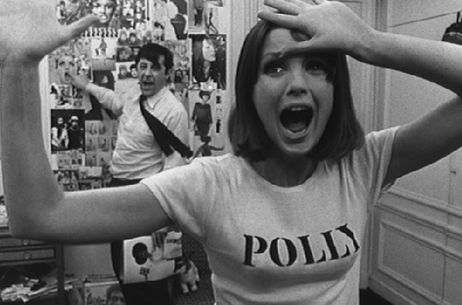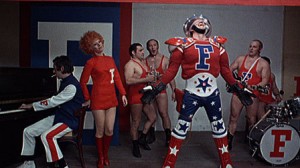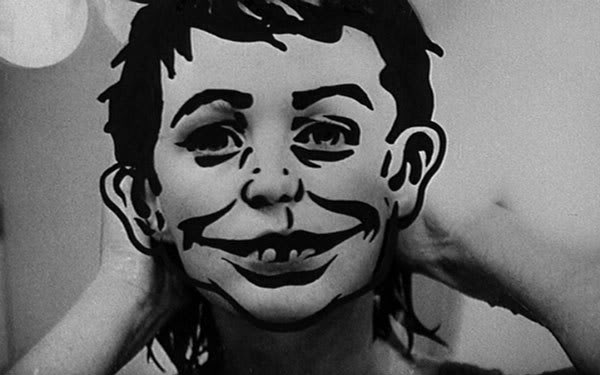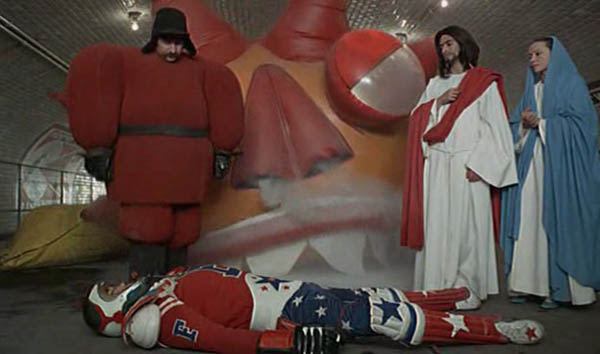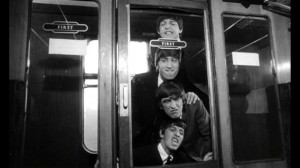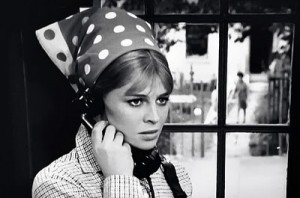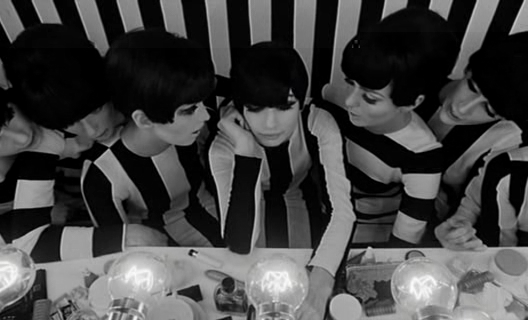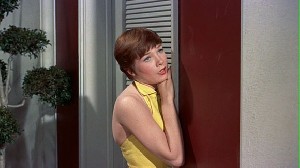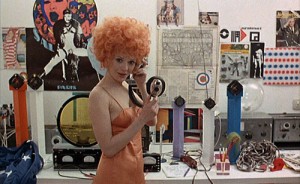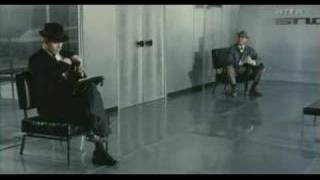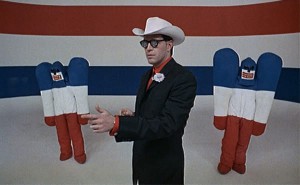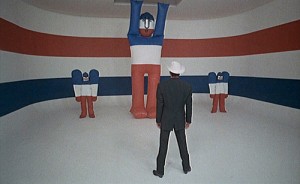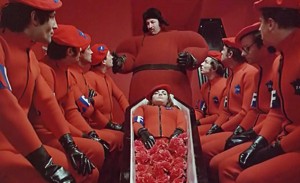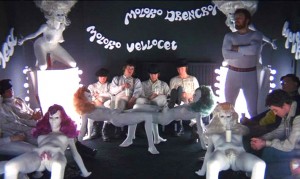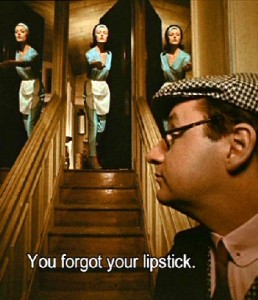From a 1989 catalog that I wrote most of for the Walker Art Center, Cinema Outsider: The Films of William Klein (an interview that accompanied this piece will also be posted on the site in a couple of days). I worked for Klein briefly in 1973, when I was living in Paris, translating a script of his called Demain la ville from French to English so that Elliott Gould, who was being considered as one of the leads, could read it. (A portion of this script was later transformed into Klein’s The Model Couple.) — J.R.
Anybody who pretends to be objective isn’t realistic. — William Klein on cinéma-vérité (1)
I have a great feeling of nostalgia for the expressionist film. Although I don’t know why I say nostalgia: such films are still being made, and as far as l’m concerned we can never go beyond expressionism. Bill Klein’s Mr. Freedom, for example, is a completely expressionistic film. Maybe that’s why it provoked such violent reactions: some people just can’t accept having reality transposed to another level. — Alain Resnais (2)
One of the limitations of conventional film history, with its subdivisions of schools and movements, is that many interesting filmmakers who are unlucky enough to exist apart from neat categories tend to disappear between the cracks. The case of William Klein, whose film work has received negligible commentary (especially in English), can partially be explained by pointing to the things he is not — or at least not quite.
He is not quite “American” — although he was born in New York City in 1928, grew up
near the intersection of 108th Street and Amsterdam Avenue, and has devoted a
substantial part of his film work to American subjects. He is not quite “French ” —
although he moved to Paris in 1948 to study painting with Fernand Léger and has
been based there ever since. He began making films in the late 1950s, around the
same time the French New wave was gaining prominence, and he might
provisionally be regarded as a member of the so-called Left Bank group, which
included Chris Marker, Alain Resnais, and Agnes Varda. Nonetheless, he is rarely
mentioned in books and surveys about the New Wave or about French cinema
in general. And although his first documentaries, from the early 1960s, are
contemporaneous with the rise of cinéma-vérité, he does not really belong in the
ranks of that movement either.
Better known as a still photographer, Klein has occupied a kind of no-man’s-land in the world of film; indeed, his importance in part derives from his capacity to straddle and confound conventional categories in both media. Consequently, it is not unusual for those who have written about Klein to fall prey to self-contradiction when they try to define his style. Consider, for example, a series of references to his work in the book Camera Lucida by the late French critic and theorist Roland Barthes. (3) There, two photographs are reproduced, and a third is described as follows:
Certain details may “prick” me. If they do not, it is doubtless because the
photographer has put them there intentionally. In William Klein’s Shinohiera
[sic], Fighter Painter (1961), the character’s monstrous head has nothing to
say to me because I can see so clearly that it is an artifice of the camera angle. (4)
Yet earlier in the book, Barthes the anti-illusionist has this to say about the first Klein photograph he
reproduces:
When William Klein photographs Mayday, 1959 in Moscow, he teaches me how
Russians dress (which after all I don’t know): I note a boy’s big cloth cap, another’s
necktie, an old woman’s scarf around her head, a youth’s haircut, etc. (5)
As Klein pointed out in a 1983 interview (6), Barthes, ignoring any artistic intention, had wanted to see the Moscow photograph only as a document of how Russians dressed and cut their hair in 1959. Yet Klein’s use of a wide-angle lens is surely as artistically crucial here as it is in Shinohara, Fighter Painter. The Muscovites, waiting for a parade to pass, represent not only an ethnic diversity but also a diversity of possible relationships between photographer and subject. Seven people are visible in the photograph. At the center is an old woman, fully aware that she is being photographed and striking a pose. But, as Klein notes, each one illustrates a possible kind of behavior in front of the camera. (7)
Is the artifice in Mayday, Moscow Klein’s wide angle or the pose of the old woman — or is it both, or neither? Juxtaposing at least two registers of camera-reality/camera-truth within the same frame (as he does in Shinohara), each of which challenges the other, Klein upsets the usual distinction we make between documentary and fiction. In his films this tension between reality and fiction is often achieved by staging and/or capturing related kinds of upsets.
Consider, for instance, how in such documentaries as Muhammad Ali the Greatest (1974), Hollywood, California: A Loser’s Opera (1977, see above), and The Little Richard Story (1980), Klein is preoccupied with representations, impersonations, and self-conscious performances that deliberately blur and multiply the essences of these films, ostensible subjects. sometimes the dispersal and multiplication of identities come from the subjects themselves: Cassius Clay turns into Muhammad Ali; Little Richard advances toward and retreats from his religious persona. (And after God reportedly tells Little Richard to walk out of Klein’s movie, the air is so thick with simulacra that we are barely aware of his absence.) Sometimes, in these films, it is a matter of fans or acting students trying on the identities of the subjects for size. And sometimes it is the fantasy-ridden obsessions of the media, duplicating, distorting, imitating, scrambling, inflating, censoring, or taking off from the images that the stars and events project.
Or consider how, in such fiction films as Qui êtes-vous, Polly Maggoo? (Who Are you, Polly Maggoo?, 1965-1966) and Mr. Freedom (1967-1968), media creations become interchangeable with “the news ” — the worlds of culture and politics. “He’s created woman!” a fashion editor declares of a couturier who is also described, paradoxically, as “the poet of sheet metal”. In Polly Maggoo, a satire about the fashion world and the media. (8) “Everything’s a fashion,” Polly remarks, “Love, ideas, even war. Even politics!” In Mr. Freedom, the preposterous, eponymous American hero, along with the foam rubber Moujik Man and inflatable Red China Man, are, simultaneously, outsized toys, overgrown nation-states, and pop American adversaries. (9)
It is at once tempting and misleading to relate Polly Maggoo and Mr. Freedom to other movies of the period. The high-contrast, black-and-white cinematography and frenetic editing of Polly Maggoo may recall Richard Lester’s A Hard Day’s Night (1964) and The Knack (1965), just as its fashion-world milieu may call to mind John Schlesinger’s Darling (1965); and Jean-Luc Godard’s Masculin-féminin (1966), with its interviews and pop satire, offers an equal number of cross-references. KIein’s brand of satirical fantasy was infectious enough at the time to have given a popular student bar in Paris the name “Polly Maggoo.” But, fueled by a kind of giddy venom and an intoxicated love-hatred for glitz, his satire has a hyperbolic energy of its own that makes it as distinct from Swinging London and the New Wave as it is from apparent Hollywood equivalents of the 1950s and early 1960s.
Similarly, the seeming influences on Mr. Freedom — the films of American director Frank
Tashlin, of Jacques Tati’s Playtime (1967), and of Godard in the mid-1960s – must be viewed
with a certain amount of caution. Tashlin, whose cartoonlike satire and use of primary colors
in such movies as Artists and Models (1955) and Will Success Spoil Rock Hunter? (1957)
had a recognizable impact on Godard. Klein, however, has said that he was unaware of any
such influence on himself. Rather, he had been amused to notice director Jacques Rivette
eagerly in line to see Artists and Models, “as if it were Potemkin,” on the first day of its
rerelease in Paris in 1973. (10) As it turned out, Rivette’s light-heartedly surreal fantasy,
Céline et Julie vont en bateau (Celine and Julie Go Boating, 1974), was directly
inspired by that Dean Martin/Jerry Lewis comedy. Regarding Playtime, it is worth
noting that John Abbey, who plays Mr. Freedom, was featured in Tati’s film as an
uptight American businessman whose stiff, mechanized movements and overall
squareness resist the festive relaxation overtaking the other characters. Whether
or not Klein cast Abbey because of Playtime, the carryover of certain of the actor’s
stances is unmistakable.
As for Godard, his work is so basic to the zeitgeist of French cinema in the 1960s that it would be difficult to assert that Klein was immune to its spell. Nevertheless, one could argue that the sheer gusto of Klein’s anti-Americanism surpasses even that of Godard. Indeed, he displays a sort of rage that could perhaps come only from an American. In addition, his savage, Ubu Roi-like burlesquing is sustained — even relentless — in contrast to Godard’s agit-prop sketches. A more apt comparison might be made with the style of Stanley Kubrick in Dr. Strangelove (1964) and, later, in A Clockwork Orange (1971). This kinship is made dramatically evident by a shot in Mr. Freedom in which Moujik Man and his minions surround a corpse — strikingly anticipating the visual design of A Clockwork Orange and suggesting that Klein’s expressionism might have been an influence on that of his fellow expatriate Kubrick.
A besetting limitation of much of the “radical” filmmaking produced by the American left in the 1960s — the work of the Newsreel and feature films such as Haskell Wexler’s Medium Cool (1969) come to mind – is its formal conservatism. This is a limitation happily unshared by Klein, whose anger, aggression, mockery, euphoria, volatility, and Punch and Judy irreverence are never gratuitously slapped onto prosaic expositions but are emotional vectors that make new forms possible — and necessary. Calling his films too angry or nasty makes about as much sense as calling a van Gogh canvas too yellow. (We have to remember that, for van Gogh, painting was in part a form of ” expressionistic documentary,” too.)
The overrating of angry iconoclasm in the 1960s as an approach to art and the underrating of it ever since have had the unfortunate result of making Klein’s early features look deceptively a la mode. Such considerations aside, there is a moral seriousness about his sequence in Loin du Vietnam (Far from Vietnam, 1967) that arguably goes beyond that of most or all of the other sections of this film,. It focuses on how an American Quaker, Norman Morrison — following the example of several South Vietnamese Buddhist monks — protested the Vietnam war by burning himself alive, and on what Morrison’s death meant to his family and to the North Vietnamese. The challenge inherent in this sequence is as clear today as it was twenty years ago, and it stands in direct contrast to the coquettish simplicity of the Resnais and Godard episodes in that film.
Stretching things a bit, one could say that the Morrison sequence and Klein’s Eldridge Cleaver, Black Panther (1970) introduce expressionism, but only through their content. On the other hand, the wide-angle distortions in many of Klein’s other films represent expressionist form. The point is that both kinds of expressionism are interjected into documentary contexts in his films.
The critic Max Kozloff, in what is perhaps the best essay about Klein to date, calls him the “poet of the epoch of McCarthy and the bomb.”(11) What Klein has done is to transport the apocalyptic dreams and demagogic humors of the 1950s into the media shows — such as the television news, sports, fashion, and politics — of the three subsequent decades. The world he depicts is a gladitorial arena in which the warriors are armed to the teeth with microphones and cameras. In this arena, the exchange of identities and the will to power are virtually interchangeable.

End Notes
1. Quoted in Ian Cameron and Mark Shivas, ” Cinéma-Vérité,” Movie 8 (April 1963), p. 21.
2. Quoted in Richard Roud, ” Memories of Resnais, ” Sight and Sound (Summer 1969), p. 120.
3. Camera Lucida: Reflections on Photography, trans. Richard Howard (New York: Hill and Wang, 1981).
4. Ibid., p. 47 .
5. Ibid., pp. 28-29.
6. ln Carole Naggar, William Klein: Photographe, etc., exh. cat. (Paris: Centre Georges Pompidou and Editions Herscher, 1983), p. 6.
7. Ibid.
8. Interestingly, this film predates Roland Barthes’ structural analysis The Fashion System by one year. The U.S. edition of that book, translated by Matthew Ward and Richard Howard, was published by Hlll and Wang in 1983.
9. One should add in this context that Klein’s recognizable contributions to the visual design of Louis Malle’s Zazie dans le Métro (1960), on which he worked as a creative consultant, are largely what gives that film a cinematographic distinctiveness mainly lacking in Malle’s other features.
10. The author in a conversation with Klein, Paris, September 1973.
11. “William Klein and the Radioactive Fifties, ” in Max Kozloff, The Privileged Eye: Essays on Photography (Albuquerque. University of New Mexico press, 1987), p. 56.

